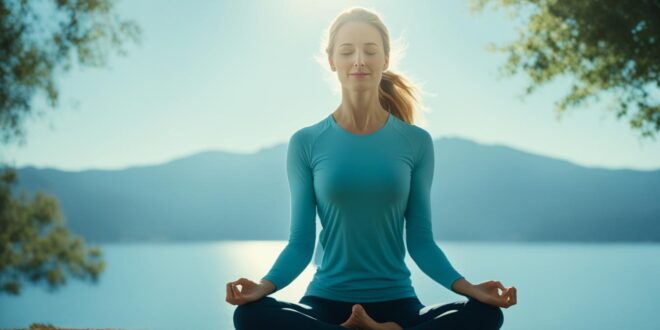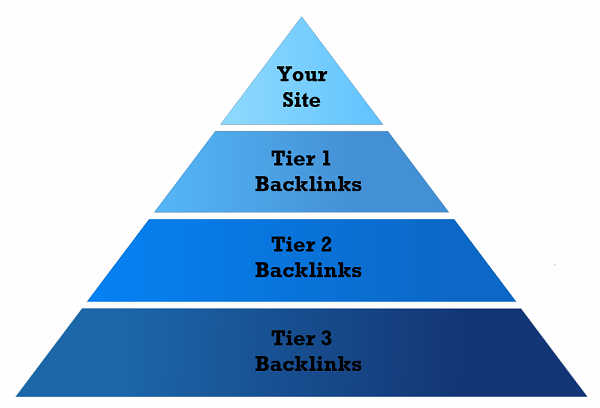Welcome to our beginner’s guide to yoga! If you’re new to yoga and looking to start your practice, you’ve come to the right place. In this article, we will explore easy yoga poses, the mental health benefits of yoga, and how to get started with yoga at home. We will also provide recommendations for yoga equipment specifically designed for beginners.
Yoga is a holistic practice that combines physical postures, breath control, and mindfulness. It is known for its ability to improve flexibility, strength, and balance, but its benefits go beyond the physical realm. Regular yoga practice can have a positive impact on mental well-being, reducing stress and promoting relaxation.
When starting yoga as a beginner, it’s important to focus on simple poses that are accessible to all bodies. These poses help build strength and develop body awareness. Props such as blocks and straps can provide support and assist with proper alignment, ensuring a safe and injury-free practice.
Starting yoga at home is a convenient option, especially for beginners. It allows you to practice at your own pace and in the comfort of your own space. We will provide essential tips on how to start your yoga journey at home, including recommendations for yoga apps that offer guided classes and tutorials.
Whether you’re looking to improve flexibility, reduce stress, or simply embark on a new fitness journey, yoga has something to offer everyone. So grab your yoga mat, put on comfortable clothing, and let’s get started on this transformative journey!
The Benefits of Yoga for Beginners
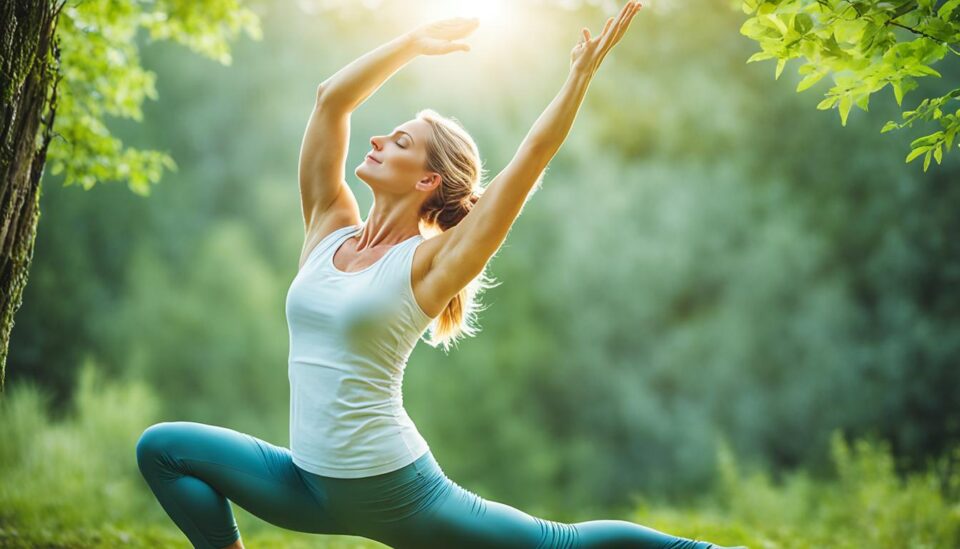
Yoga offers numerous benefits for beginners, including stress relief, increased strength, weight loss, and improved mental well-being. The practice of yoga has therapeutic aspects that can help manage various health conditions and promote overall wellness. Regular yoga practice can help beginners develop strength, flexibility, and balance, while also calming the mind.
One of the key benefits of yoga is its ability to relieve stress. The combination of deep breathing, gentle movements, and mindfulness helps to activate the body’s relaxation response, reducing the production of stress hormones and promoting a sense of calm and relaxation.
In addition to stress relief, yoga also helps beginners build strength. While yoga may not involve heavy weights or intense cardio workouts, it focuses on using body weight and targeted movements to develop strength and tone muscles. Poses such as Plank, Warrior, and Chair pose engage the core, arms, and legs, helping beginners build functional strength.
Yoga is also an effective practice for weight loss. While it may not burn as many calories as high-intensity workouts, it can contribute to weight loss by improving metabolism, reducing stress-induced overeating, and promoting a mindful and intuitive approach to eating.
Furthermore, the therapeutic aspects of yoga make it beneficial for managing various health conditions. Yoga has been shown to improve symptoms of chronic pain, insomnia, anxiety, and depression. The combination of gentle movements, deep breathing, and mindfulness can have a positive impact on physical and mental well-being.
By regularly practicing yoga, beginners can develop flexibility, allowing greater range of motion and reducing the risk of injury. The gentle stretching and holding of yoga poses helps lengthen muscles, increase joint mobility, and improve overall flexibility.
In conclusion, for beginners, yoga offers a holistic approach to wellness, providing stress relief, increased strength, weight loss, and improved mental well-being. Its therapeutic aspects make it suitable for managing various health conditions. With regular practice, beginners can not only develop physical strength and flexibility but also find inner peace and balance.
Starting Yoga at Home: Essential Tips
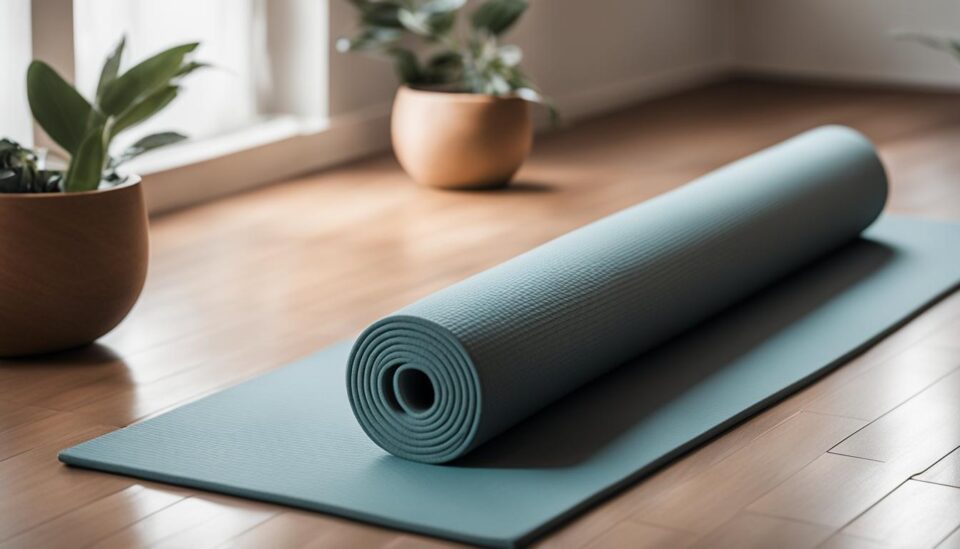
Embarking on a yoga journey from the comfort of your own home can be a rewarding and convenient way to experience the numerous benefits of yoga. Whether you are a complete beginner or transitioning from studio classes to a home practice, it’s important to establish a solid foundation. Here are some essential tips to help you start your yoga practice at home.
Familiarize Yourself with Yoga Basics
Before diving into a home practice, take the time to familiarize yourself with the basics of yoga. This includes understanding proper alignment and learning fundamental poses. Online resources, tutorial videos, and yoga books can provide valuable guidance and instruction in mastering the yoga basics.
Invest in a Quality Yoga Mat
A good-quality yoga mat is essential for a comfortable and safe practice. It provides cushioning for your joints and stability during poses. Look for a mat that offers proper grip, thickness, and durability to support your practice effectively. A yoga mat with a non-slip surface will ensure stability as you move through different poses.
Essential Yoga Equipment
While yoga can be practiced with minimal equipment, investing in a few essentials can enhance your practice. Blocks and straps can be used to modify poses and provide support if you have limited flexibility. These props can help you maintain proper alignment and prevent injuries as you explore different poses at home.
Explore Yoga Apps
In the digital age, there are numerous yoga apps available that cater to beginners. These apps offer guided classes and tutorials, making it easier to follow along and learn the basics. Look for apps that provide clear instructions and a variety of classes to suit your skill level and preferences. With a yoga app, you can enjoy the benefits of a guided practice from the comfort of your own home.
Starting your yoga practice at home can be an empowering and enriching experience. By familiarizing yourself with the basics, investing in quality equipment, and utilizing yoga apps, you can establish a strong foundation for your home practice. Embrace the journey and enjoy the many physical, mental, and spiritual benefits that yoga has to offer.
Easy Yoga Poses for Beginners
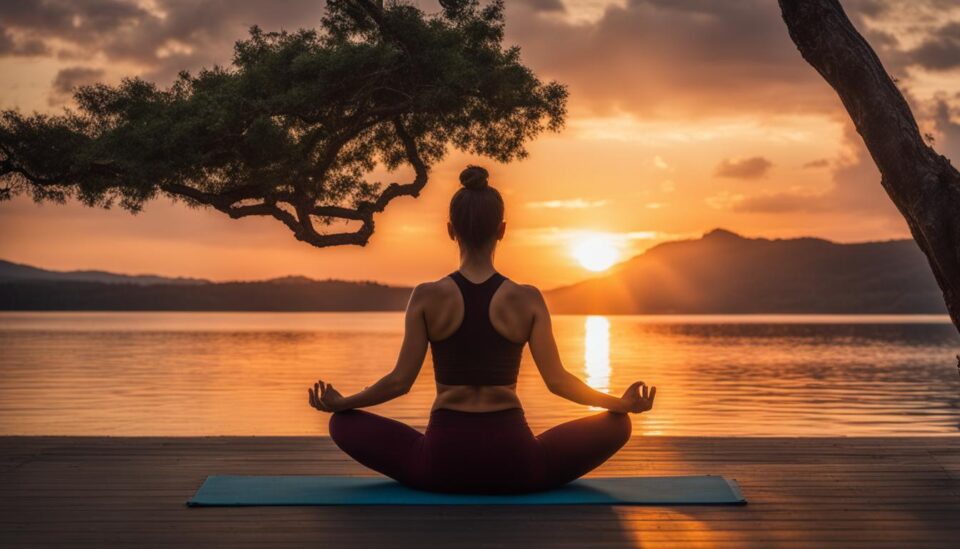
Are you new to yoga and looking for easy yoga poses to get started? As a beginner, it’s important to start with poses that are accessible and gentle on the body. These poses will help you build strength, flexibility, and body awareness, laying the foundation for more advanced yoga sequences and postures.
1. Mountain Pose
The Mountain pose, also known as Tadasana, is a simple standing posture that promotes balance and stability. Stand with your feet hip-width apart, toes pointing forward. Ground your feet into the mat, engage your thigh muscles, and lengthen your spine. Relax your shoulders, with your arms by your sides and palms facing forward. Take deep breaths, feeling the connection between your feet and the earth.
2. Child’s Pose
Child’s pose, or Balasana, is a restful pose that helps to stretch the back, hips, and thighs. Start by kneeling on the mat with your big toes touching and your knees hip-width apart. Sit back on your heels and lower your torso forward, resting your forehead on the mat. Extend your arms long in front of you or alongside your body, palms facing up. Breathe deeply and surrender into the pose, allowing tension to release.
3. Cat/Cow Pose
Cat/Cow pose, or Marjaryasana/Bitilasana, is a dynamic sequence that improves spinal flexibility and mobility. Begin on all fours with your wrists directly under your shoulders and your knees under your hips. Inhale, arch your back, drop your belly, and lift your head and tailbone (Cow pose). Exhale, round your spine, tuck your chin, and draw your belly button towards your spine (Cat pose). Flow between these two poses, syncing your breath with the movement.
Remember, as a beginner, it’s important to practice these poses with proper alignment and listen to your body. If a pose feels uncomfortable or challenging, you can always modify it to suit your abilities. Regular practice of these easy yoga poses will help you develop strength, flexibility, and body awareness, setting the stage for a rewarding yoga journey.
Yoga for Different Age Groups
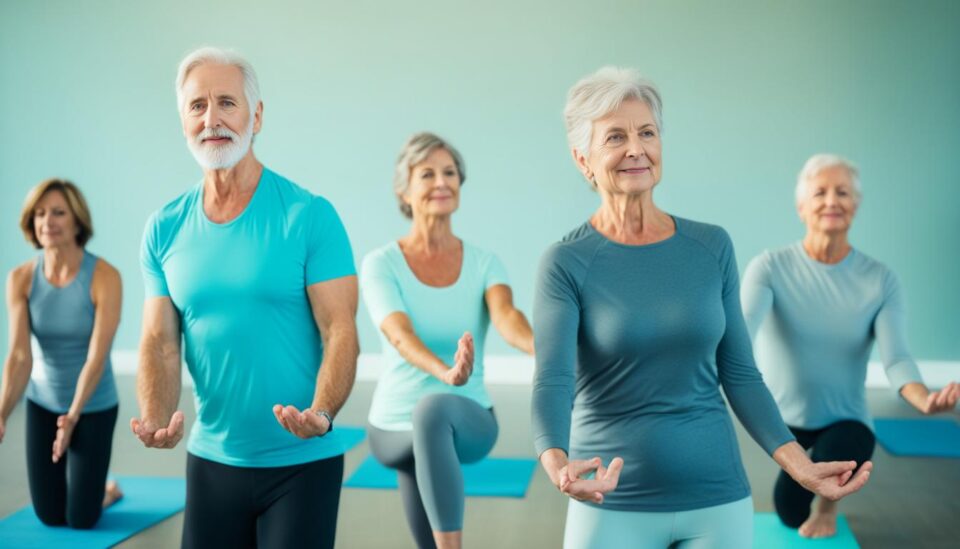
Yoga is a versatile practice that caters to people of all ages. Whether you’re a child, an adult, or an older adult, yoga offers unique benefits for every age group.
Benefits for Children
- Improved Coordination: Yoga poses help children develop coordination, balance, and body awareness.
- Enhanced Focus: Yoga teaches children to concentrate and be present in the moment, improving focus and attention span.
Benefits for Adults
- Promotes Flexibility: Regular yoga practice enhances flexibility, making everyday movements easier and reducing the risk of injuries.
- Strength Building: Yoga poses engage muscles throughout the body, helping adults build strength and stability.
- Stress Relief: Yoga combines physical movement and mindfulness, providing a soothing effect on the body and mind, reducing stress levels.
Benefits for Older Adults
- Gentle Movements: Yoga offers gentle movements that help older adults maintain mobility, improve balance, and reduce stiffness.
- Increase in Mobility: Regular yoga practice can increase joint mobility and flexibility, enhancing overall physical well-being.
Regardless of age, yoga provides a multitude of benefits. It’s a practice that can be modified to suit individual needs and abilities. So, whether you’re young or young at heart, incorporating yoga into your routine can contribute to a healthier and more balanced lifestyle.
Yoga Diet: Nourishing Your Practice

While there isn’t a specific “yoga diet,” it’s important to nourish your body to support your yoga practice. A balanced and healthy diet plays a crucial role in providing the necessary nutrients for energy, strength, and overall well-being.
Here are some key elements to consider when it comes to your yoga diet:
Fruits and Vegetables
Fruits and vegetables should be the foundation of your diet. They are rich in vitamins, minerals, and antioxidants, which support your immune system and help reduce inflammation. Aim for a variety of colors to ensure you’re getting a diverse range of nutrients.
Whole Grains
Whole grains such as quinoa, brown rice, and whole wheat bread provide complex carbohydrates that can sustain your energy levels throughout the day. They also offer fiber, which aids in digestion and helps you feel fuller for longer.
Lean Protein
Include lean protein sources in your diet to support muscle growth and repair. Options include chicken, turkey, fish, tofu, lentils, and beans. These protein-rich foods help with post-workout recovery and provide essential amino acids.
Healthy Fats
Incorporate sources of healthy fats into your diet, such as avocados, nuts, seeds, and olive oil. These fats provide crucial nutrients and support brain health. They also help you feel satiated, preventing overeating.
Hydration
Staying hydrated is essential for any physical activity, including yoga. Proper hydration aids in muscle function, helps with digestion, and regulates body temperature. Aim to drink water throughout the day, particularly before, during, and after your yoga practice.
A nourishing yoga diet is built on whole, natural foods that nourish your body and mind. By adopting a balanced and healthy approach to eating, you can enhance the benefits of your yoga practice and support your overall well-being.
Cultural Roots and History of Yoga

Yoga, with its cultural roots deeply embedded in ancient Indian philosophy, has evolved over thousands of years, drawing influences from various traditions and cultures. This rich history spans centuries and has been practiced by yogis and spiritual seekers worldwide, making it a truly global phenomenon.
The practice of yoga can be traced back to the ancient texts of Hinduism, such as the Vedas and the Upanishads, where it was initially developed as a spiritual discipline. It was later expanded upon by the sage Patanjali in the Yoga Sutras, which provided a comprehensive framework for the practice of yoga.
Yoga encompasses not only physical postures (asanas) but also breath control (pranayama), meditation (dhyana), and ethical principles (yamas and niyamas), all aimed at achieving self-realization and connecting with the divine.
Over the centuries, yoga has transcended its religious origins and has been adopted and adapted by various cultures and societies. It has become a global practice, with millions of people around the world practicing yoga for its physical, mental, and spiritual benefits.
Today, yoga is not only a means of attaining physical fitness and flexibility but also a holistic approach to well-being, offering tools for stress reduction, mental clarity, and inner peace.
Understanding the cultural roots and history of yoga provides a deeper appreciation for its origins and the wisdom it carries. It allows us to connect with the ancient traditions that have shaped this profound practice and continue to resonate with so many people today.
Yoga Challenges for Beginners

Starting a yoga practice can be both exciting and challenging, especially for beginners. As you embark on your yoga journey, you may encounter a few hurdles along the way. Let’s explore some common challenges that beginners often face and how to overcome them.
1. Flexibility
Flexibility is one of the key aspects of yoga, and it’s something that many beginners struggle with. You may find yourself unable to touch your toes or hold certain poses for an extended period. Remember, flexibility is not a prerequisite for practicing yoga. With regular practice, you’ll gradually improve your flexibility and range of motion. Be patient with yourself and listen to your body’s limits.
2. Balance
Balance poses can be particularly challenging for beginners. It may take time to find stability and cultivate a strong sense of balance. Practice standing poses like Tree pose or Warrior II to enhance your balance. Utilize props, such as blocks or a wall, to help you maintain stability as you build your strength and find your center of gravity.
3. Learning New Poses
Learning new yoga poses can sometimes feel overwhelming, especially with the abundance of poses available. Take it one step at a time and focus on mastering a few poses before moving on to more advanced ones. Follow tutorials or seek guidance from a qualified yoga instructor who can provide proper alignment cues and modifications tailored to your needs.
4. Patience and Consistency
Yoga is a practice that requires both patience and consistency. Progress may not be instant, but with dedication and regular practice, you will see improvements over time. Embrace the journey and focus on the process rather than perfection. Celebrate small victories along the way and remember that every yoga practice is an opportunity for growth.
5. Working with a Qualified Instructor
Having a qualified yoga instructor by your side can greatly benefit beginners. An instructor can provide personalized guidance, correct your alignment, and offer modifications based on your individual needs and limitations. Consider attending a beginner’s yoga class or working with an instructor one-on-one to ensure a safe and effective practice.
By acknowledging these common challenges and approaching your yoga practice with patience, consistency, and guidance, you can overcome them and make progress on your yoga journey. Embrace the challenges as opportunities for growth and remember that every step forward, no matter how small, brings you closer to reaping the numerous benefits of yoga.
Yoga for Mental Health and Stress Relief
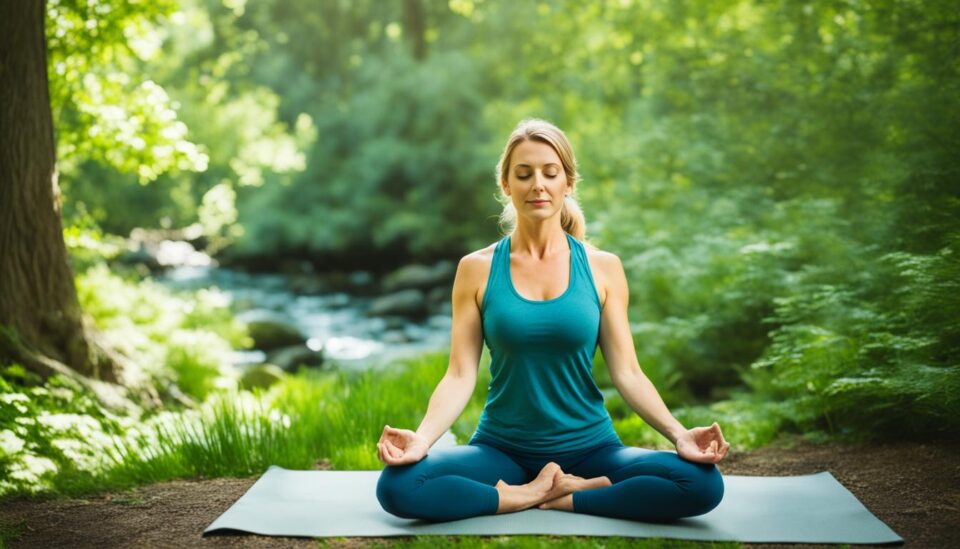
Yoga is widely recognized for its mental health benefits, including stress relief and relaxation. The practice of yoga incorporates deep breathing, mindfulness, and physical movement, which can help reduce anxiety, improve mood, and promote overall well-being.
Regular yoga practice has been shown to effectively manage stress and its related symptoms. By engaging in yoga, individuals can find a sense of calmness and inner peace, allowing them to better cope with the challenges and pressures of daily life.
One of the key mechanisms through which yoga helps manage stress is by activating the body’s relaxation response. This response triggers a release of endorphins, known as the body’s natural feel-good hormones, which can bring about a sense of well-being and alleviate stress.
Additionally, the deep breathing exercises practiced in yoga can help regulate the autonomic nervous system, responsible for controlling the body’s stress response. By calming the nervous system, yoga can reduce the production of stress hormones and induce a state of relaxation.
Furthermore, the mindful and meditative aspects of yoga encourage present-moment awareness and non-judgmental acceptance. This can help individuals become more attuned to their emotions and thoughts, and develop a greater sense of self-awareness and self-compassion.
By incorporating regular yoga practice into their routines, individuals can experience the profound effects of stress reduction, improved mental clarity, and enhanced overall well-being.
- Reduce anxiety
- Improve mood
- Promote relaxation
- Enhance mindfulness
- Cultivate self-awareness
Beginner Yoga Workouts for Flexibility and Strength
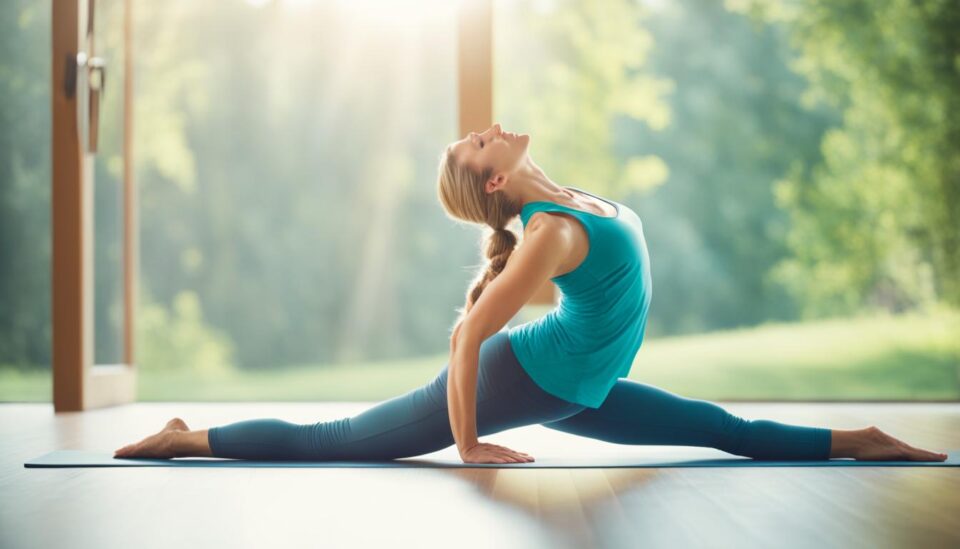
For beginners in yoga, focusing on improving flexibility and building strength is essential. Beginner yoga workouts typically include a combination of stretching poses and strength-building poses that target different muscle groups. Gradually increasing the intensity and duration of these workouts can help beginners improve their flexibility and build strength over time.
Stretching poses such as Downward Dog, Forward Fold, and Cobra can help improve flexibility by elongating the muscles and increasing their range of motion. These poses also help to release tension and promote relaxation.
Strength-building poses such as Warrior I and II, Chair pose, and Plank pose target the major muscle groups in the body, including the legs, arms, core, and back. These poses help to increase muscle tone, improve stability, and promote overall strength.
In addition to individual poses, beginner yoga workouts may also include flowing sequences that combine different poses in a continuous and fluid movement. These sequences help to improve coordination, balance, and overall body awareness.
It is important for beginners to practice at their own pace and listen to their bodies. Modifications and props can be used to adapt poses to individual abilities and prevent injury. As beginners progress in their yoga practice, they can gradually increase the duration and complexity of their workouts to continue challenging their flexibility and strength.
Yoga Equipment Guide for Beginners
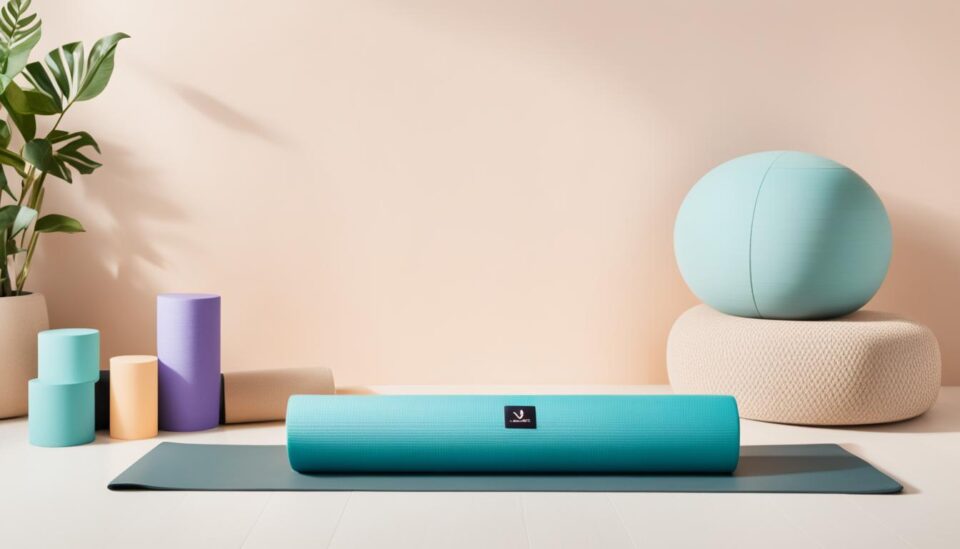
As a beginner starting your yoga journey, it is crucial to invest in the right yoga equipment to ensure a comfortable and safe practice. The right equipment can enhance your experience and support proper alignment during poses. Here are some essential yoga equipment items for beginners:
1. Yoga Mat
The most important piece of equipment for any yogi, beginners included, is a good-quality yoga mat. A yoga mat provides cushioning, stability, and grip, allowing you to practice safely and comfortably. Look for a mat that is thick enough to provide adequate support but not too thick that it compromises stability. Choose a mat with a non-slip surface to prevent slipping during poses and ensure stability.
2. Blocks
Yoga blocks are versatile props that can assist beginners in achieving proper alignment and deepen their stretches. They can be used to modify poses, extend reach, and provide support when flexibility is limited. Blocks come in different materials such as foam, cork, or bamboo. Choose a material that feels comfortable and offers stability.
3. Straps
Yoga straps are excellent tools for beginners to improve flexibility and reach in poses. They help extend your reach and allow you to comfortably hold poses that might otherwise be challenging. Straps are typically made of durable nylon or cotton and have adjustable buckles or loops. Look for straps that are long enough to accommodate your flexibility level.
4. Bolsters
Bolsters are cylindrical cushions that provide support, stability, and comfort during restorative and gentle yoga poses. They can be used to prop up specific body parts, such as the back or knees, to encourage relaxation and proper alignment. Bolsters come in a variety of sizes and materials. Choose one that suits your body type and provides adequate support.
Remember, investing in the right yoga equipment will enhance your yoga practice and make it more enjoyable. Choose equipment that suits your individual needs and preferences, considering factors such as comfort, durability, and support. By having the essential yoga equipment, you’ll be well-equipped to embark on your yoga journey with confidence.
Yoga Apps for Beginners
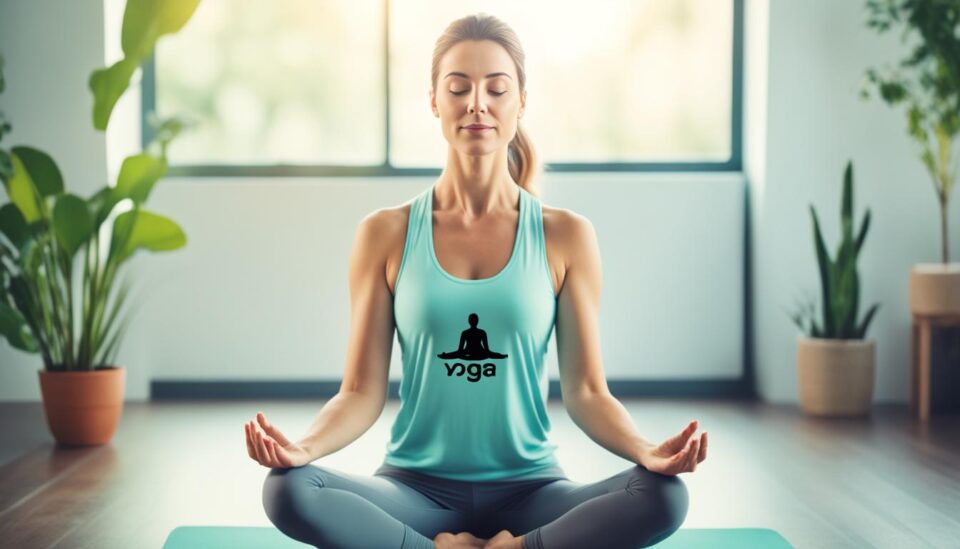
Yoga apps can be a valuable resource for beginners on their yoga journey. These apps provide a convenient way to access guided classes, tutorials, and personalized practice plans from the comfort of your own home. Whether you’re just starting out or looking to enhance your existing practice, yoga apps offer a variety of features to support your progress.
One of the key benefits of yoga apps is the access to guided classes. These classes are designed specifically for beginners and provide step-by-step instructions on how to perform different poses and sequences. With clear demonstrations and audio cues, you can easily follow along and learn correct alignment and breathing techniques.
Many yoga apps also offer tutorials that focus on specific aspects of yoga, such as improving flexibility or learning advanced poses. These tutorials break down the movements and provide tips and modifications to help beginners safely explore new challenges in their practice.
Another advantage of using yoga apps is the ability to customize your practice. These apps often have features that allow you to create personalized practice plans based on your goals and preferences. Whether you want to focus on strength, flexibility, stress relief, or all of the above, you can tailor your practice to suit your needs.
When choosing a yoga app, it’s important to consider the reputation and credentials of the app developer. Look for apps that offer clear instructions and guidance from qualified yoga instructors. Reading user reviews and ratings can also help you gauge the app’s effectiveness and user-friendliness.
With the convenience and flexibility of yoga apps, beginners can embark on their yoga journey with confidence and guidance. Whether you’re looking to establish a consistent practice, explore new poses, or simply unwind and relax, yoga apps provide the tools and support you need to thrive.
Therapeutic Aspects of Yoga
Yoga is a holistic practice that offers therapeutic benefits for individuals with specific health conditions or concerns. It has been widely recognized as a complementary therapy for various ailments, including chronic pain, insomnia, anxiety, and depression. The therapeutic aspects of yoga can help improve physical and mental well-being, providing a natural and holistic approach to health and healing.
For individuals experiencing chronic pain, yoga can help reduce inflammation, increase flexibility, and strengthen the muscles surrounding the affected areas. The gentle stretching and controlled movements in yoga poses can promote healing and alleviate discomfort. Similarly, individuals struggling with insomnia can benefit from the relaxation techniques and mindfulness that yoga promotes, helping to calm the mind and achieve a deeper and more restful sleep.
Anxiety and depression often go hand in hand, and yoga offers a powerful tool for managing the symptoms of both conditions. The combination of physical movement, deep breathing, and mindfulness in yoga practice can help reduce stress levels, regulate emotions, and promote a sense of calm and clarity. Furthermore, the sense of community and support that can be found in yoga classes can also contribute to improved mental well-being.
Yoga provides individuals with a safe and nurturing space to connect with their bodies, minds, and spirits. It encourages self-care, self-awareness, and self-acceptance. Through regular practice, individuals can cultivate a deeper understanding of themselves and develop resilience in the face of challenges. The therapeutic aspects of yoga truly offer a holistic approach to health and healing, promoting balance and well-being in all aspects of life.
 Sharing is Caring Blog Something different…
Sharing is Caring Blog Something different…
